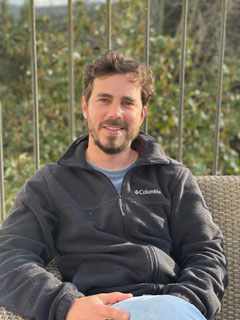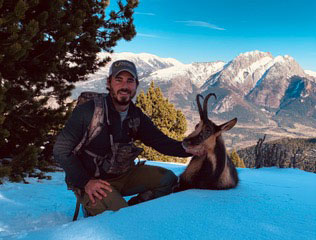Professional Hunter Spotlight – Pablo Carol Wild Hunting Spain
From a young age, hunting has been a way of life for Pablo. His uncle introduced him to it. Pablo traveled the world with him, honing his skills with each trip, also meeting many outfitters, hunting professionals and organizations. Travelling provided the opportunity to get to know different hunting regions. He began combining his university studies with guiding hunts.
In 2011, Pablo made a life-changing decision to dedicate himself to hunting and founded Wild Hunting Spain. He comments on the motivation for that action: “During years as a parttime guide, being in direct contact with hunters, I began thinking about establishing my own company. I knew I would be happier in the field than in an office. I believed I would be successful if I did what I was passionate about. Now, at the age of 34, with a decade of operating my own company, I think that was one of the best decisions of my life. My passion for nature and the countryside, coupled with the dream of turning my hobby into a way of life, pushed me to work hard to achieve what was and continues to be my dream.”

Wild Hunting Spain has exclusive hunting areas for all the species in Spain. Near Barcelona, six different species found are Pyrenean chamois, Iberian mouflon, Iberian red deer, fallow deer, roe deer and wild boar. It is the only country in the world where there are four different ibex species, plus two chamois species and other species unique on the Iberian Peninsula. Each offers the hunter a different challenge and varied experiences, depending on which ibex is being hunted. Pablo is especially proud of his ibex hunts in Spain, which include the four different species SCI recognizes.
The famous Beceite ibex is found south of the Pyrenees. The Gredos mountain range is home to the dark-bodied Gredos ibex with its unique lyre-shaped horns. In the extreme south, Malaga province, the smallest of the four Spanish ibex can be hunted. A few years ago, the SCI World Record was taken there. Near Ronda in the Sierra Nevada mountains, the Southwestern ibex is found.
Pablo responds to the question of what sets his outfit apart from others: ”Wild Hunting Spain is a small company offering a more personalized service that has become a trademark and many clients have become good friends. I love it when my guests immerse themselves in Spanish culture and take away the experience of having lived as a local, even for a few days. The majority of our hunts take place in vast free range hunting areas which we pre-scout so we know where to find the trophies. This, together with minimal hunting pressure in those areas, has given us a 100 percent success rate.”
When afield, Pablo explains which firearms he carries. “I love mountain hunts, so I prefer to use the lightest weapon possible with a very flat caliber in case I need to fire a long-range shot. I like to use carbon rifles like Sauer 404 XTC or Blaser R8, which I have in 7mm Rem. Mag, .270 Win and .308 calibers.”
Every hunting day is different, but some are etched in memory. Pablo shares his outstanding experiences: “I go through my photo collection of clients’ hunts and remember the days we spent together. The wonderful thing about hunting is that every day is different. At an SCI Convention, I met an elderly man named Jeff who had the dream of shooting an ibex. He was worried that he would be unable to do a mountain hunt because of his physical condition and gradually losing his sight. We spoke a bit and I encouraged him to have a go. I told him we would try our best to help arrange his dream. I believed if we chose the right moment and had good pre-scouting, we would have a strong possibility of getting his trophy.
“Eventually, Jeff came to Spain. Before his arrival the locals found two beautiful Ibex in a not especially difficult area. It was the rutting season and those impressive creatures were always with their respective group of females, one not far from the other. We knew when we located the females, the male would not be far away.
“On the first day, a cold December morning, we headed for the place where we’d seen the largest of the two males. It was a magnificent old ibex, the kind of trophy any hunter would be proud of. Every day for a week we’d seen it with its group of females.
“The Ibex was in a little valley and as soon as we arrived, we saw this group. We took up positions at about 200 yards and waited patiently for the big boss to make an appearance. The hours passed and it seemed the male wasn’t going to show up.
“We waited five more long hours but did not see the ibex. We decided to go to with Plan B and made our way to the other group of ibex where the male was not as large but would still be a good one.

“For a couple of hours, we walked slowly and as we got closer to our destination, we started to hear the unmistakable sound of two ibex fighting. Seeing them we realized the two males were the ones we’d located the week before in the two separate groups.
“Quietly and cautiously, we took a position at about 250 yards from the two males and observed these two beasts fighting. We decided to shoot the bigger Ibex – the one we originally planned to hunt.
“Jeff, at the age of 85, realized his dream of shooting an Ibex and returned home with a huge first class Beceite ibex and an extraordinary experience I doubt he will ever forget. “
Spain is a well-established tourist destination and offers a wealth of different activities for its visitors. WHS meets the wishes and needs of guests. A variety of activities can be arranged, practically anything related to Spanish tourism and culture. Spain is a great country for fishing.
Pablo comments on WHT’s activities: “I believe hunters have a duty to get involved in education and conservation projects and the industry should support them. I am involved in both institutional and personal international projects. Locally, we have programs to keep the animal population healthy. I am a member of SCI and collaborate with the Iberian Chapter. I work with the SCI Foundation and its Blue Bags program. Since 2016, I have been a Master Measurer. The Registry has become an invaluable source of information regarding the listed species’ habitats and characteristics and other information.”

